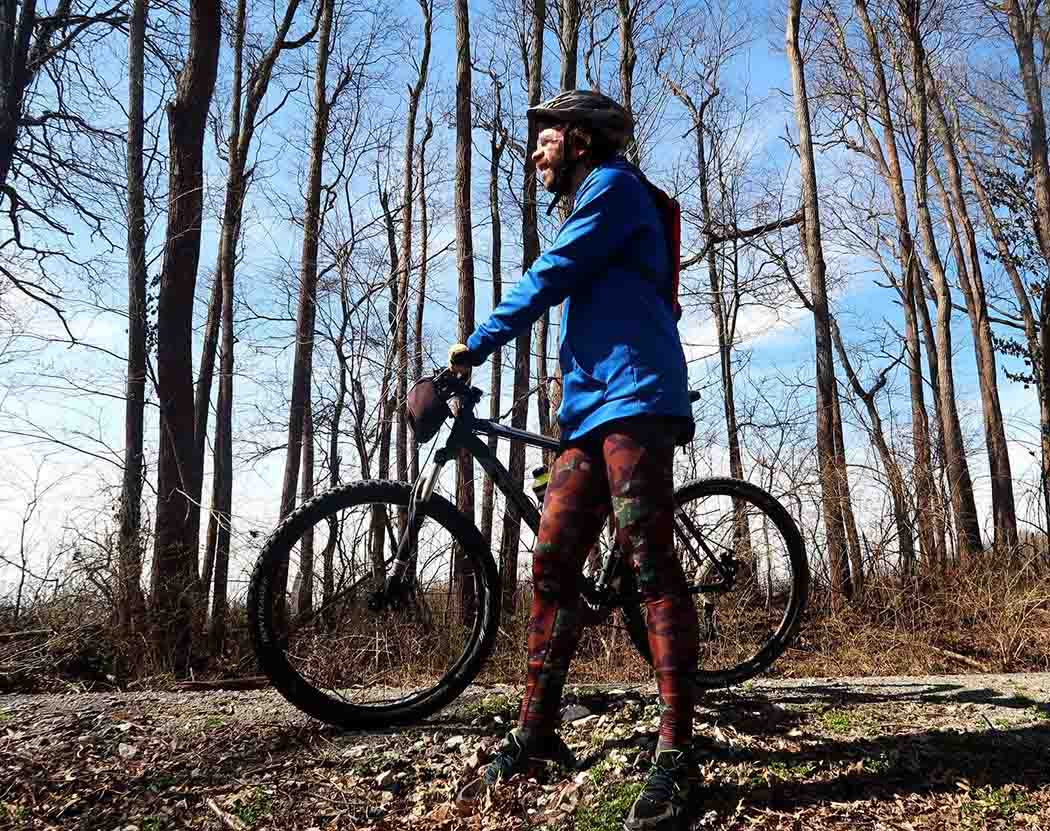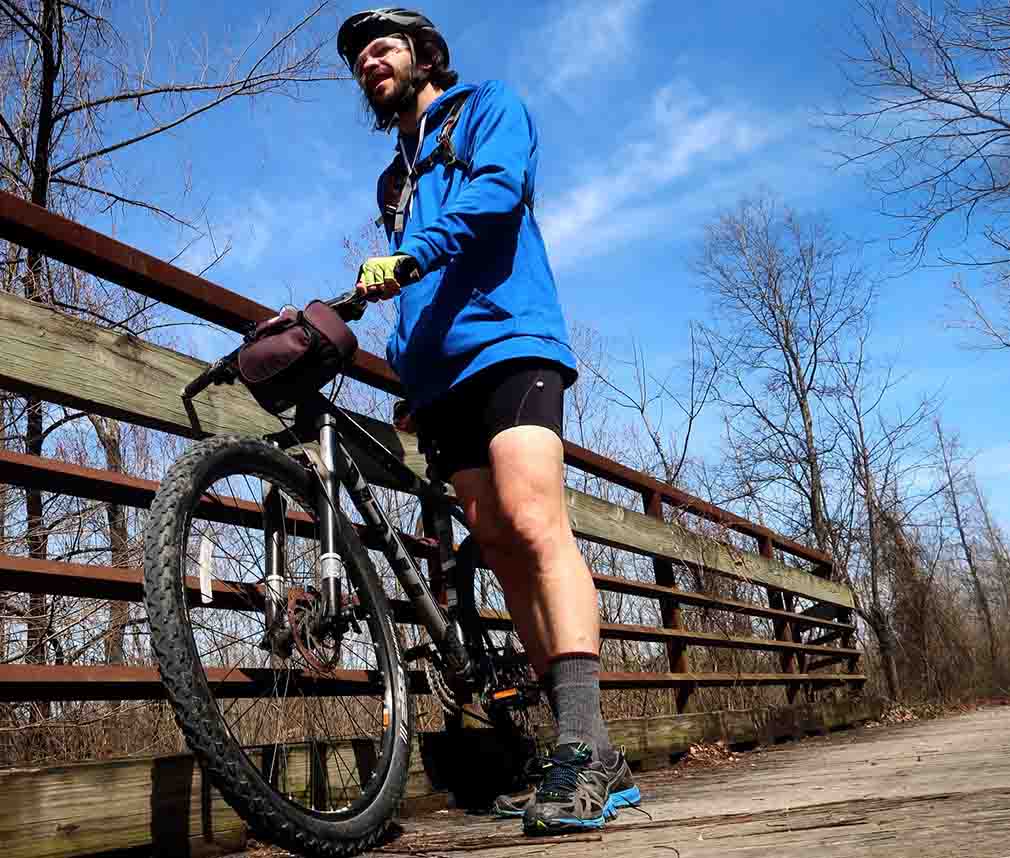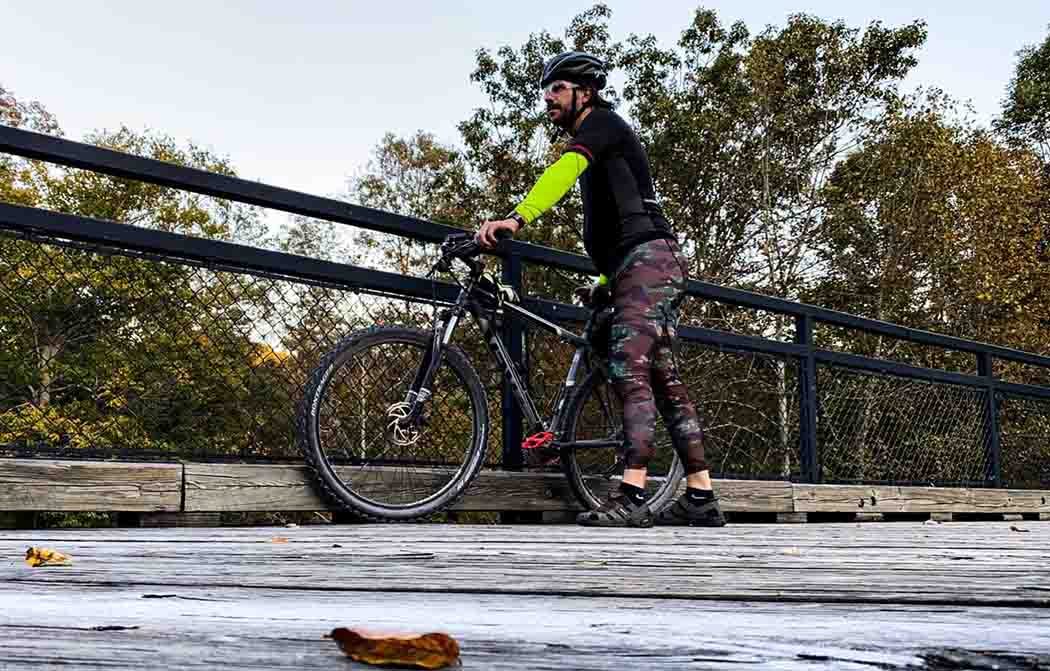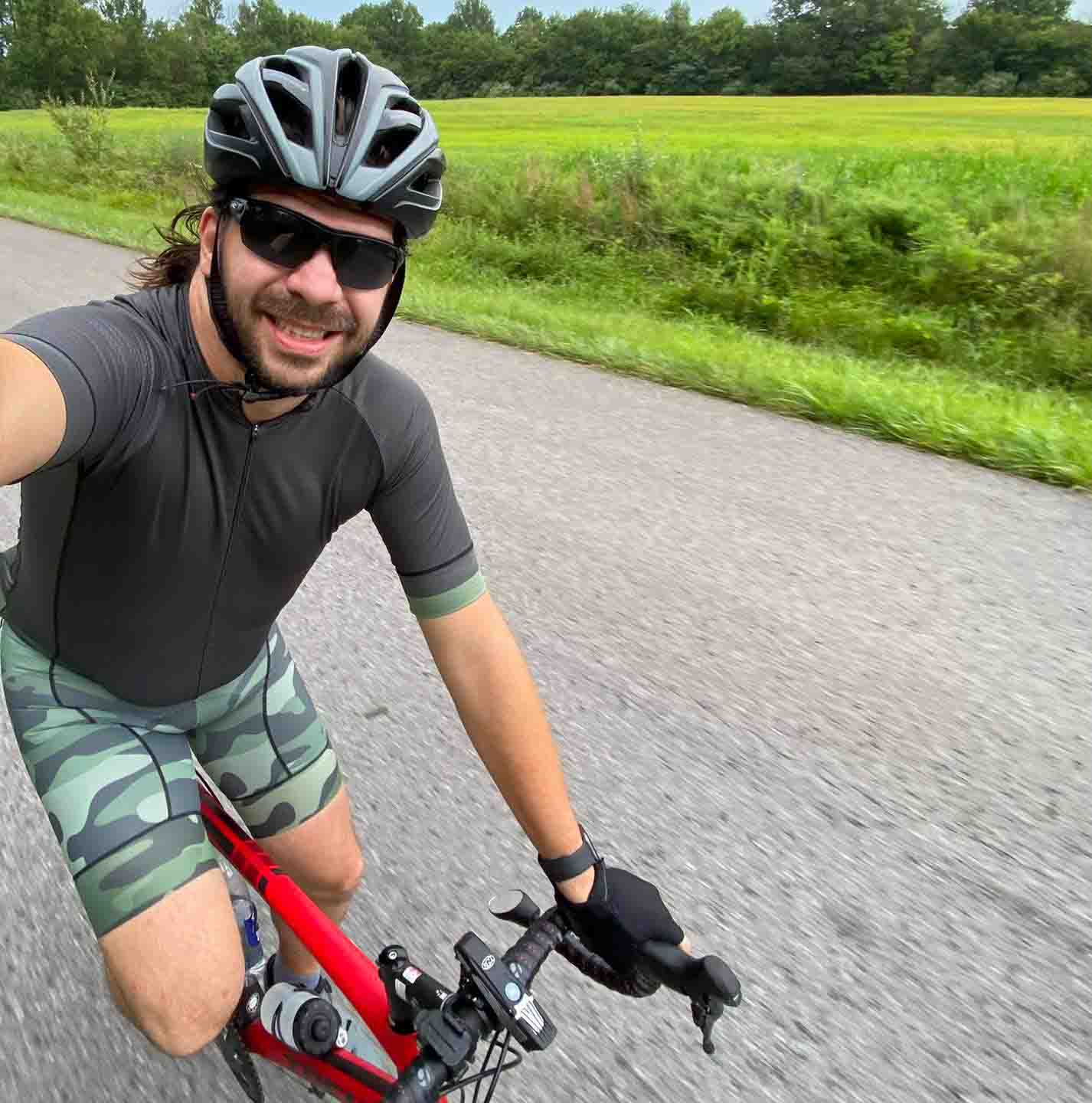23 Important Winter Cycling Tips + Free Winter Bike Kit Checklist
Winter cycling is upon us.
Many cyclists quit riding during the winter. Snow, ice, cold – why bother getting on the bike, right? You could get hurt a lot easier.
Riding inside on the trainer is always an option. But it gets pretty boring riding inside for some.
And if you quit riding, you lose all that you’ve worked up to during the warmer months. Then, when spring comes back, you work all year to get it back, only to lose it again when the winter cycling season returns.
I got a better idea for you. Keep cycling all year long. I’ll give you 23 tips to help you do just that, AND throw in a free winter cycling kit checklist to help you out even further.
Basic Winter Cycling Tips
Let’s take a look at some basic winter cycling tips that everyone should follow to enjoy their bicycle all winter long.
1 – Ease into Winter Cycling
Start slow and ease your way into cycling during the winter months. Get adjusted to the cold and get an understanding of how you need to change your clothing and gear. When you rush into cycling during cold weather; that’s when you hate it the most as a result.
2 – Winterize Your Riding Techniques
Change the way you typically ride to cope with winter cycling challenges and issues. This might mean riding on a cleared shoulder instead of an uncleared bike lane. You might need to bring extra layers and have more weight because of it. Change is required when cycling in the cold.
3 – Don’t Be S.A.D.
S.A.D. stands for Seasonal Affective Disorder. It’s what makes us dreary and depressed during the colder months. This is because most activities end in these colder seasons. But cycling indoors or outdoors can keep you from letting the colder months get you down.
4 – Avoid Winter Cycling Hazards
Try to avoid major risks and hazards when cycling in the winter. For example, a rail trail or bike path might be safer than riding on the road when some ice and snow are still present. Be prepared to stop more during the winter because more hazards will require more stops.
5 – Look Ahead More Often
It’s easy to not pay attention while riding the bike. The winter brings new challenges to drivers. They will stop more and make more mistakes. You need to be looking ahead as often as possible to avoid becoming a part of their mistakes and hazards.
6 – Try New Bike-Friendly Routes
During winter cycling, you should give new bike routes a shot. Go for routes that fewer people are using as long as you can get your bike safely through them. You might also choose popular routes because it will be the clearest of winter precipitation.
7 – Try to Plan Your Bike Ride Better
Planning and preparedness will keep you safe when cycling in the winter. Before you ride, try to map out what your ride will look like. Stick to the plan to stay prepared for whatever might happen during your ride. You’ll face many more hazards when you do something without being prepared for it.
8 – Organize Bike Rides
Try organizing some group rides with your friends and bike club members. The more riders, the more visible you are and the safer your ride can be. Everyone can help motivate one another to bike in the colder weather, too. Riding with others is a great idea during the winter cycling season.
9 – Ride with Other Cyclists
If you can’t get a group ride going, at least ride with another cyclist. Two cyclists are safer than one. You can keep each other company and not sit there and think about the cold. It’s easier to spot two people on the road than one when driving, too.
10 – Ride Inside on the Trainer
If it’s too bad outside, consider riding inside on your trainer. You can use a program like Zwift and enjoy indoor cycling with others, or you can watch YouTube videos to help motivate you to ride. Invest in a good trainer or stationary bike so that you can keep enjoying cycling when you’re forced to enjoy it inside.
11 – Take More Breaks off the Bike
Take more breaks off your bike during the winter. Don’t try to ride as much as you would during the warmer months. You burn a lot more energy when exercising in the cold. Your body will need longer and more frequent breaks from fitness.
12 – Eat Well, Hydrate Well
Eat well and hydrate often. You should be doing this before, during, and after your bike ride. We tend to forget to fuel and hydrate when the weather is colder. That will make you bonk out earlier than you want to. Stay fueled and hydrated this winter.
13 – Hit the Gym on Rest Days
You can keep exercising on rest days if you want to. Instead of relying on cycling every day, try other fitness activities like going to the gym. Work on legs, arms, and core on different days. The stronger you are all over your body, the better cyclist you’ll become.
14 – Give Running a Try
If the gym isn’t your thing, go for a run. Running and trail running is a great alternative to cycling for your rest days. It doesn’t take long to get warm when running, either. If there are any 5K events going on, sign up for them and enjoy a run.
15 – Keep Your Head, Hands, and Feet Warm
When cycling in the cold, you need to keep certain body parts warm in order to enjoy the remainder of your ride. These parts include your head, ears, hands, and feet. If those parts are warm, you’ll likely have a great bike ride without too much discomfort from the cold.
16 – Add a Coffee Shop to Your Route
Warm up by adding a coffee stop to your route. This gives you a chance to stop and stretch, take a break, and warm up with a hot beverage. You can also socialize with others in your group or around the shop. Add one or two of these on your route, especially longer routes.
17 – Slow Down a Little
You don’t need to go that fast during the winter cycling season. The roads will be more hazardous than normal. It’s typically colder outside. You risk more injury and incidents. Slow down a little bit and take it easy when cycling in the winter months.
Winter Cycling Gear Tips
When it comes to winter cycling, paying more attention to your cycling gear and equipment will help you in the long run.
18 – Ride a Familiar Bike
The last thing you want to do is ride an unfamiliar bike during winter conditions. If you have to dodge hazards on the road or path, you want to ride a bike that you’re familiar with. Unless you have no choice, save the new bike for a better day.
19 – Bring the Right Gear
Make sure you bring the right cycling gear with you on colder winter days. This may include extra layers, rain gear, and extra fuel and hydration for your ride. It usually gets dark earlier in the winter, so you’ll want to bring lighting with you in most cases.
20 – Check Tire Pressure Habitually
Try to check your tires and tire pressure before every ride. Your tires will often lose pressure during the colder months. This is even common among cars and trucks. Try to make it a habit to always check your tire pressure before you go out on a bike ride.
21 – Layer Up and Be Seen
Layer up during the winter cycling season. Wear layers that you can take off and add to as the temperature fluctuates. Try to choose cycling apparel that is bright in color. Plain black is easy to ignore, but bright colors catch the attention of drivers very quickly.
22 – Keep Your Bike Clean
The winter cycling season brings more lasting precipitation in the air and on the ground. This means more dirt and grime will attach to your bike. That dirt and grime can wear out your bike’s components and even damage things. It’s a good idea to clean your bike after every use outdoors to prolong the life of it and its components.
23 – Keep Your Batteries Warm
Batteries drain quickly in colder weather. You might have batteries for your gear shifting, camera, bike computer, and other electronic devices you use. Keep the batteries close to your body to keep them warmer and prolong their life in the colder weather. You might also keep a hand warmer around them to add extra heat, but don’t get them too hot.
BONUS: Winter Cycling Kit Checklist
As a bonus to this guide, you get to enjoy this free winter cycling kit checklist to help you keep warm during your winter weather cycling adventures.
Bib Tights
Bib tights are full or ¾ length (often called knickers) tights used for cycling. These are like bib shorts as they have shoulder straps on them. Some bib tights are insulated and have water resistance built into them, and some have no insulation at all. Some have a chamois built in, while others do not have one. You can either wear bib tights alone or use the unpadded ones to add an extra layer over your cycling shorts.
Thermal Bib Shorts
Thermal bib shorts are padded cycling shorts with shoulder straps but have thermal materials added to them. These are like bib tights but are shorts instead. The idea of these is to use on cooler days where you can add leg warmers for extra warmth if you need them. I get hot easily, so being able to take the warmers off really saves my day when I’m out cycling.
Warmers
Warmers are insulated sleeves that cover your legs, knees, and arms. These are often worn with short-sleeved jerseys and bib shorts. They’re meant to be worn and removed for layering purposes on cooler days.
Vest
A cycling vest comes in many different materials, types, and styles. It’s meant to be an extra layer for colder days. It would be an idea for those wearing short-sleeved jerseys with warmers. It would add an extra layer to the upper area that the warmers are not covering.
Base Layers
A base layer is typically a tight-fitting insulated or non-insulated moisture-wicking shirt. You might wear it under your jersey for extra layers or to keep more moisture from your skin.
Jersey
A jersey is a short or long-sleeved zip-up shirt used for cycling. It could be insulated or non-insulated. It is made with materials that keep moisture off your skin. Some zip all the way up and down, while others zip halfway down and up. Most cycling jerseys come with three large pockets in the back, and some have additional smaller zip pockets perfect for keys and money clips.
Jacket
A cycling jacket is a dedicated jacket made for cycling. Most of these jackets are wind-resistant and waterproof. Most cycling jackets fit closer to the skin versus regular jackets.
Rain Gear
Rain gear may include a rain jacket, rain pants, and a helmet cover. These are often worn when cycling on cold, rainy days. These items are often baggier than most cycling apparel but are meant to be worn over normal cycling kits.
Gloves
There are many styles of cycling gloves to choose from. Most summer gloves have the fingers cut out from them. Most winter gloves are full-fingered and insulated.
Socks
There are cycling socks. You can get thinner summer cycling socks or thicker winter cycling socks. Cycling socks come in my different styles.
Bike Shoes
Bike shoes are typically the kind of shoe that connects to bike pedals. Ironically, these pedals are known as clipless pedals. The shoes have clips on the bottom of them that can be attached to pedals. This keeps you in the pedals and allows for more stabilization and control of your bike.
Bike Shoe Covers
Bike shoe covers are usually for the toe region or the full shoe. Most are made with a neoprene or similar material. They’re used to help block wind and rain from getting through your shoe and to help keep your feet warm.
Neck & Face Covers
Neck and face covers come in different styles. A neck gator is often used to keep wind and cold from hitting your neck. A full face cover is often called a Balaclava and can keep most parts of your face, head, and neck covered. General face masks may be used for warmth and to mitigate the spread of germs.
Cycling Cap or Beanie
A cycling cap or beanie is meant to help keep the cold from hitting your head. Some caps protect the ears, while others just cover the head.
Final Thoughts About Winter Cycling
Winter cycling is a great way to enjoy the outdoors if you’re prepared for it. Using the many tips and winter kit ideas above will help you stay prepared.
If you enjoyed reading this article, please share it with other cyclists who might also enjoy reading it.
Be sure to follow us on X if you haven’t already.
About Shawn Gossman
Shawn Gossman is the author of this post and founder of the Beginner Cycling Tips Blog.
Shawn has been an avid cyclist for around 12 years. He road, gravel, mountain, and trail bikes. He likes adventuring more than racing.




